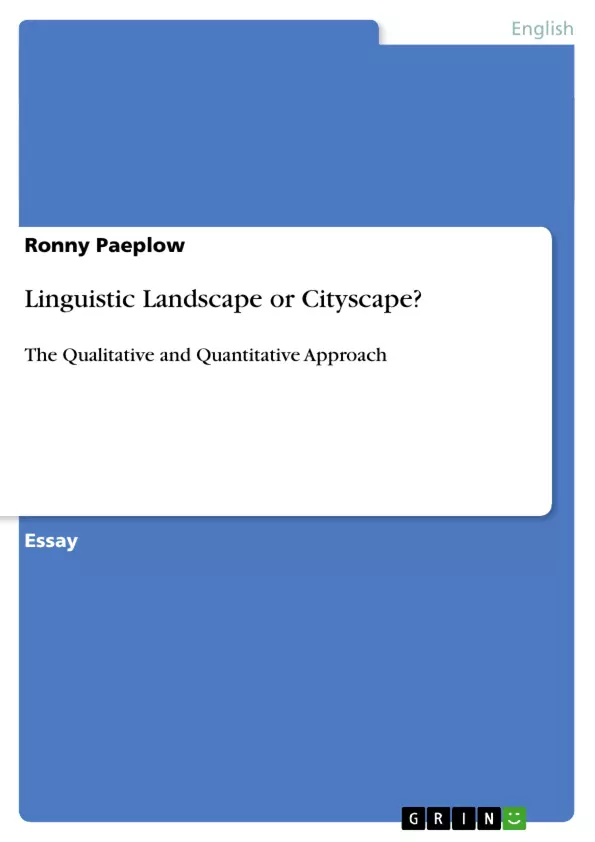Introduction
This term paper is about the qualitative and quantitative approach in studying a
cityscape. First, I will show that their should be a difference in meaning and usage
between the two terms 'linguistic landscape' and 'cityscape' and then suggest a
definition for 'cityscape'. Then I will introduce the field of 'sociolinguistics' and the
two approaches, namely 'qualitative' and 'quantitative', which are very helpful in order
to study a cityscape. At the End I will summarise the whole topic showing the
similarities and differences of the qualitative and quantitative approach.
Inhaltsverzeichnis (Table of Contents)
- Introduction
- Cityscape
- Sociolinguistics
- Observer's Paradox
- Quantitative versus Qualitative
Zielsetzung und Themenschwerpunkte (Objectives and Key Themes)
This term paper aims to differentiate between the terms "linguistic landscape" and "cityscape" and to explore the application of qualitative and quantitative approaches within sociolinguistics to study a cityscape. It investigates the definitions of "linguistic landscape" and proposes a definition for "cityscape" that encompasses both written and spoken language in a given region. The paper also examines the role of sociolinguistics in understanding language use within a social context.
- Defining "linguistic landscape" and "cityscape"
- Exploring the methodologies of qualitative and quantitative research in sociolinguistics
- Analyzing the relationship between language and society within urban environments
- Addressing the observer's paradox in sociolinguistic research
- Comparing and contrasting the strengths and limitations of qualitative and quantitative approaches
Zusammenfassung der Kapitel (Chapter Summaries)
- Introduction: This section introduces the paper's central topic: the qualitative and quantitative study of a cityscape. It establishes a distinction between "linguistic landscape" and "cityscape" and previews the paper's structure.
- Cityscape: This chapter critically examines various definitions of "linguistic landscape," highlighting the differing scopes and methodologies employed by different researchers. It argues for a broader definition of "cityscape" that includes both written and spoken language in the public sphere.
- Sociolinguistics: This section defines sociolinguistics and explores its relevance to the study of cityscapes. It discusses the interplay between language and society, emphasizing the role of language in establishing and maintaining social relationships and its use in identifying social groups.
- Observer's Paradox: This chapter introduces Labov's "observer's paradox"—the challenge of observing language use without influencing the data. It highlights the importance of minimizing observer influence to obtain accurate and reliable data.
- Quantitative versus Qualitative: This section compares and contrasts the quantitative and qualitative approaches to sociolinguistic research. It notes that while both require data collection and documentation, their methodologies and interpretations differ significantly.
Schlüsselwörter (Keywords)
Linguistic landscape, cityscape, sociolinguistics, qualitative research, quantitative research, observer's paradox, language and society, urban multilingualism, visual signs, written language, spoken language.
- Citation du texte
- Ronny Paeplow (Auteur), 2011, Linguistic Landscape or Cityscape? , Munich, GRIN Verlag, https://www.grin.com/document/182905



